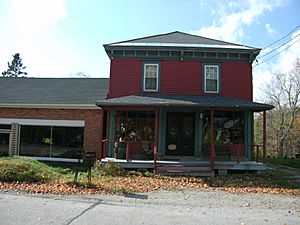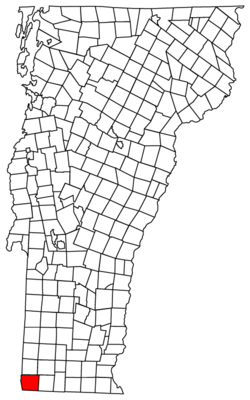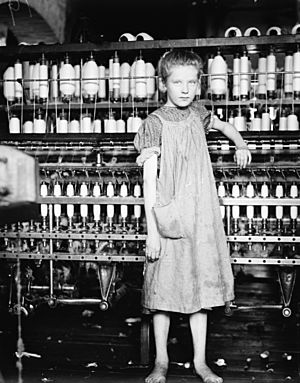Pownal, Vermont facts for kids
Quick facts for kids
Pownal, Vermont
|
|
|---|---|

Former Country Store
|
|

Pownal, Vermont
|
|
| Country | United States |
| State | Vermont |
| County | Bennington |
| Communities | Pownal North Pownal Pownal Center |
| Area | |
| • Total | 46.7 sq mi (121.0 km2) |
| • Land | 46.4 sq mi (120.3 km2) |
| • Water | 0.3 sq mi (0.7 km2) |
| Elevation | 1,398 ft (426 m) |
| Population
(2020)
|
|
| • Total | 3,258 |
| • Density | 70/sq mi (27.1/km2) |
| Time zone | UTC-5 (Eastern (EST)) |
| • Summer (DST) | UTC-4 (EDT) |
| ZIP codes | |
| Area code | 802 |
| FIPS code | 50-57025 |
| GNIS feature ID | 1462179 |
Pownal is a town in Bennington County, Vermont, United States. In 2020, about 3,258 people lived here. Pownal is made up of a few smaller communities: Pownal, North Pownal, and Pownal Center.
Contents
Pownal's Past: A Look Back
Early Settlers and Land Claims
Long ago, the Mahican people lived in the area that is now Pownal. Other groups, like the Mohawks, also traveled through this land. In the late 1600s, some Europeans might have arrived. They were part of a large Dutch land grant called the Manor of Rensselaerswyck. This area later came under English control in 1664.
The first European settlers likely came in the 1730s. They might have been Dutch or other Europeans who rented land. On January 28, 1760, New Hampshire Governor Benning Wentworth officially created Pownal. He named it after another governor, Thomas Pownall.
Soon after, settlers, mostly from England, arrived from Massachusetts, Connecticut, and Rhode Island. In 1766, many men in Pownal asked King George III to recognize their land claims. They also asked for the fees to be removed.
Conflicts and the American Revolution
Governor Wentworth had given land that New York also claimed. This led to fights between "Yorkers" (from New York) and settlers in the New Hampshire Grants. Because of these problems, many Pownal residents joined the Green Mountain Boys. This group was led by Ethan Allen.
During the American Revolution, Pownal was divided. Some people, called "Yankees," supported the American cause. Others, called "Tories," were loyal to England. Tories were often arrested and put in prison.
These tensions were so strong that when British General John Burgoyne's army came to the area, Vermonters fought on both sides. The Battle of Bennington was a big American victory. After the Revolution, most Tories left Pownal. They moved to Canada to be with other United Empire Loyalists.
The Mooar-Wright House is the oldest house in Pownal and possibly in Vermont. It might have been built in the 1750s. Some believe a man named John Defoe built it. He was a Tory who fought for the British. Others think Charles Wright built it in 1765.
Independent Spirit and Community
Pownal citizens have always been proud of their independent spirit. In 1789, a visiting minister described the town as having "miserable inhabitants" with "no religion." He noted there were Baptists, Quakers, and some Presbyterians, but no church building.
Today, Pownal has five churches. The oldest, Pownal Center Community Church, started in 1794. It was called the Union Church and served both Baptists and Methodists. The first church was made of logs. In 1849, the current church building was built. It is owned jointly by the town and the church.
Notable People and Industries
In 1851, Chester Arthur (who later became President of the United States) was the principal of a boys' academy in Pownal. This academy helped boys get ready for college. Another future president, James Garfield, also taught in North Pownal.
During the 1800s, both cotton and woolen mills operated in Pownal. The wool industry was very busy between 1820 and 1840. Farmers continued to raise sheep into the 1900s. A woolen mill in North Pownal operated from 1849 until it burned down in 1863.
The Plunkett & Barber Co. Mill was built in 1866. It was a cotton mill until 1930. Later, it became a tannery (a place where animal hides are made into leather) in 1937. It closed in 1988. The mill site is now being cleaned up and will become a recreation area.

In the early 1900s, a photographer named Lewis Hine took a picture of twelve-year-old Addie Card working in the mills. He called her an "Anemic Little Spinner." This photo was even featured on a U.S. stamp that honored the first child labor laws. A novel, Counting on Grace, was inspired by Addie Card's story.
Trolley service started in Pownal in 1907, connecting it to Williamstown and Bennington. This service stopped in 1927. The old brick power station for the trolleys is still standing.
Lime quarries (places where limestone is dug up) operated in North Pownal until 1936. A special rail line carried the stone to a mill. There, it was crushed and packed for shipping.
The Green Mountain Race Track opened in 1963. It hosted both horse racing and greyhound racing. The track closed in 1992. Since then, it has sometimes hosted events like rock concerts and antique car shows.
Camp Ilium: A Scouting Start
The YMCA's Camp Ilium was located in Pownal. This camp is special because on September 10, 1910, S. F. Lester became the first person to be a certified Scoutmaster in the Boy Scouts of America. He led 30 scouts to Camp Ilium that year. This camp was the beginning of the Boy Scout Movement for Pownal and Troy, New York.
Pownal's Location and Landscape
Pownal is the town farthest southwest in Vermont. It shares borders with Williamstown, Massachusetts, to the south and Petersburgh, New York, to the west. It also borders the Vermont towns of Stamford, Woodford, and Bennington. Pownal is actually closer to Hartford, Connecticut, than it is to Burlington, Vermont.
The town covers about 121 square kilometers (46.7 square miles). Most of this area is land, with a small part being water. The Hoosic River flows through Pownal. This river eventually flows into the Hudson River.
Two main highways cross Pownal: U.S. Route 7 and Vermont Route 346. U.S. Route 7 is the town's main road. Vermont Route 346 is a shorter road that follows the Hoosic River.
The Long Trail, America's oldest long-distance hiking trail, starts in Pownal. It begins near the border with Massachusetts, inside the Green Mountain National Forest. This part of the Long Trail is also part of the famous Appalachian Trail. The Green Mountain Club created and manages the Long Trail.
Pownal's Population
| Historical population | |||
|---|---|---|---|
| Census | Pop. | %± | |
| 1790 | 1,746 | — | |
| 1800 | 1,692 | −3.1% | |
| 1810 | 1,655 | −2.2% | |
| 1820 | 1,812 | 9.5% | |
| 1830 | 1,835 | 1.3% | |
| 1840 | 1,613 | −12.1% | |
| 1850 | 1,742 | 8.0% | |
| 1860 | 1,731 | −0.6% | |
| 1870 | 1,705 | −1.5% | |
| 1880 | 2,019 | 18.4% | |
| 1890 | 1,919 | −5.0% | |
| 1900 | 1,976 | 3.0% | |
| 1910 | 1,599 | −19.1% | |
| 1920 | 1,396 | −12.7% | |
| 1930 | 1,425 | 2.1% | |
| 1940 | 1,402 | −1.6% | |
| 1950 | 1,453 | 3.6% | |
| 1960 | 1,509 | 3.9% | |
| 1970 | 2,441 | 61.8% | |
| 1980 | 3,269 | 33.9% | |
| 1990 | 3,485 | 6.6% | |
| 2000 | 3,560 | 2.2% | |
| 2010 | 3,527 | −0.9% | |
| 2020 | 3,258 | −7.6% | |
| U.S. Decennial Census | |||
In 2000, Pownal had 3,560 people living in 1,373 households. About 34% of these households had children under 18. The average household had about 2.59 people.
The population's age breakdown in 2000 showed:
- 25.4% were under 18 years old.
- 7.6% were from 18 to 24.
- 28.9% were from 25 to 44.
- 27.0% were from 45 to 64.
- 11.1% were 65 years or older.
The average age in Pownal was 38 years.
Famous People from Pownal
- Samuel S. Ellsworth: A U.S. Congressman from New York.
- James Fisk: A well-known businessman from the 1800s.
- Abraham B. Gardner: A Lieutenant Governor of Vermont.
- Barbara Howes: A poet.
- Amby McConnell: A Major League Baseball player.
Pownal's Climate
Pownal has a climate with big changes in temperature throughout the year. Summers are warm to hot and often humid. Winters are cold, sometimes very cold. This type of climate is called a humid continental climate.
See also
 In Spanish: Pownal (Vermont) para niños
In Spanish: Pownal (Vermont) para niños




